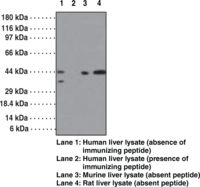| References |
| Formulation |
100 µg protein G-purified IgG in 200 µl PBS containing 0.2% gelatin and 0.05% sodium azide |
| Stability |
6 months |
| Storage |
-20°C |
| Shipping |
Wet ice
in continental US; may vary elsewhere
|
| Specificity |
| Bovine SMAD3 |
(+) |
| Canine SMAD3 |
(+) |
| Human SMAD3 |
(+) |
| Murine SMAD3 |
(+) |
| Porcine SMAD3 |
(+) |
| Rat SMAD3 |
(+) |
| Rhesus Monkey SMAD3 |
(+) |
Show all 7
Hide all but first 3
|
| Size |
Global Purchasing |
| 100 µg |
|
Description
Antigen:
portion of amino acids 100-150 of human SMAD3
·
Host:
rabbit
·
Application(s):
IHC and WB
·
SMAD3, a member of the SMAD family of proteins, is involved in the TGF-β signaling cascade. A human homolog of Drosophila Mad protein, SMAD3 consists of an N-terminal DNA-binding MH1 domain, a linker region and a C-terminal MH2 domain. It is a receptor-regulated SMAD (R-SMAD) that functions downstream of TGF-β and activin receptors and mediates their signaling.1,2 It is recruited by SARA (SMAD anchor for receptor activation) to the receptor kinase for phosphorylation. Upon phosphorylation, SMAD3 dissociates from SARA, forms a complex with SMAD4 and transmigrates into the nucleus where it complexes with other cofactors and acts as a transcription factor. It has an indispensable role in cell proliferation, differentiation, apoptosis and formation of ECM. Loss of SMAD3 results in Childhood T-cell leukemia.
1
Shi, Y., and Massaro, A.F. Mechanisms of TGF-β signaling from cell membrane to the nucleus. Cell 113 685-700 (2003).
2
Qin, B.Y., Suvana, S.L., Correia, J.J., et al. Smad3 allostery links TGF-β receptor kinase activation to transcriptional control. Genes Dev 16 1950-3 (2002).
|






